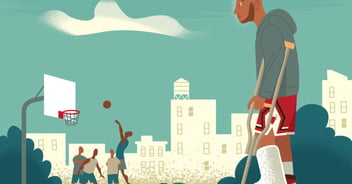You are special if you play and train all winter long. You are a winter warrior!
However, winter warriors, like you, need extra safety from injuries in winter. Winter sports are inherently more dangerous. In 2015, over 246,000 people were treated for winter sports injuries, according to the U.S. Consumer Product Safety Commission. Here in Canada, more 5,600 people are seriously injured during winter sports activities every year, according to Canadian Institute for Health Information.
The winter climate is far less forgiving than other seasons. Plus, sun exposure and hydration are still a concern. While not all these injuries are avoidable, knowledge increases safety.
Here we will discuss most common injuries that occur while playing winter sports.
Skiing and Snowboarding Injuries
Skiing and snowboarding are among the most popular winter activities. However, these activities also cause the most number of winter sport injuries.
These activities include descending steep slopes covered with snow at high speed. The snow-covered slopes may cause you to slip, hit an object, or fall over. In addition, use of a secondary sports equipment (ski, snowboard, pole) during such activities increases the risk of injury. Concussions, fractures, and twisting muscles are common injuries that occur during skiing or snowboarding.
To reduce the risk of concussions, always wear helmets during any activity where speed is a concern. Also, make sure your children wear helmets as well.
Also, a severe fall can injure limbs or body to a varying degree. Avoid going near sharp cliffs, dangerous heights, or rocky paths to stay safe.
Tobogganing and Snowmobiling Injuries
Both tobogganing, also called sledging or sledding, and snowmobiling involve using sports equipment, similar to skiing and snowboarding. But the equipment is much larger, and powered in case of snowmobiling. Such equipment complicates the safety of the person involved. While the larger equipment offers better protection, it also pose risks due to a person falling over or carried away with the snowmobile.
The injuries include fractures, concussions, to severe body injuries. To reduce the risk, always wear proper protective equipment, fasten the belts, and operate the toboggans and snowmobiles safely.
Hockey Injuries
Winter season is also a hockey season. Throughout the season, numerous hockey teams train and play games with each other. During these hockey games, serious injuries happen to players frequently.
In the game, players collide with each other, hit the glass, and fall on ice. These incidents can result in concussions, torn ligaments, and fractured bones.
For safety, make sure to wear all hockey equipment when on the ice. Avoid any kind of dangerous or foul play. Enforcing rules to create safe and fair play conditions is also important for the hockey players.
Skating Injuries
Skating on ice is a favorite activity of many people. While comparatively safer to other winter activities, it still poses a few risks.
Slipping on ice is the most common incident, especially for people who are new or less experience with skating. Injuring yourself while falling over or hitting into other people while skating are other safety concerns. Always wear the safety equipment and try to maintain distance from others while on the ice.
If you are skating outside, ensure the ice is safe every time you skate. Do not just assume it is safe because other people are skating on it, or because you skated on it yesterday.
Jogging and Running Injuries
Running and jogging outdoors is an effective way to keep yourself in shape, provided you are prepared for the season. However, dangerous surface conditions are often risky to runners.
In the winters, the risk of shin splints, cramps, ankle and knee injuries while running increases. You can minimize these risks by sticking to paths that you know well.
For safety, stay off the road and use the sidewalk or a park path. The road may look cleaner, but ice is harder to detect on the road. Plowed snow may also make the roadway narrow and give cars less space to maneuver around you.
Changing up your footwear in the winter is another step towards safety. By switching to a cross-trainer shoe, you can maintain grip better and keep your feet warm as well.
Related: Sports Injuries and Middle Age
Hiking and Walking Injuries
While hiking and walking seem safer when compared to other activities, they still contain many risks during the winter. The risk increases due to the unfamiliar paths covered with snow and ice.
To avoid injuries, always watch your step and look ahead to avoid stepping at the wrong spot. Most common injuries are due to slipping and falling, which result in fractures or bruises.
In addition, you have to be careful of frost bites while hiking in extreme cold temperatures.
Related: Slip and Fall Injuries in Snow
Cycling Injuries
With specialized bicycles, cycling has become an all-weather activity in Canada. However, bicycles are still prone to losing balance and crashing on snow and ice. These crashes might cause severe head and body injuries to the cyclist, including permanent disability or death.
For safety in snow and slippery weather, some bicycles come equipped with tires specially designed to work on snow and ice for safety. Additionally, you can stay off uneven surfaces and snow-covered roads to avoid crashes.
And remember, always wear a helmet.
Final Words
Being a winter warrior is all about preparing yourself and knowing a step ahead. Wearing a helmet, staying warm, following the rules, and switching up your normal exercise gear will help you stay safe in the snow and ice.
We hope this information will help you keep fighting all winter long.

